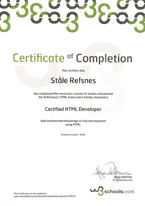HTML - XHTML
What Is XHTML?
- XHTML stands for EXtensible HyperText Markup Language
- XHTML is almost identical to HTML 4.01
- XHTML is a stricter and cleaner version of HTML 4.01
- XHTML is HTML defined as an XML application
- XHTML is supported by all major browsers.
Why XHTML?
Many pages on the internet contain "bad" HTML.
The following HTML code will work fine if you view it in a browser (even if it does NOT follow the HTML rules):
<html>
<head>
<title>This is bad HTML</title>
<body>
<h1>Bad HTML
<p>This is a paragraph
</body>
<head>
<title>This is bad HTML</title>
<body>
<h1>Bad HTML
<p>This is a paragraph
</body>
XML is a markup language where documents must be marked up correctly and "well-formed".
If you want to study XML, please read our XML tutorial.
Today's market consists of different browser technologies. Some browsers run on computers, and some browsers run on mobile phones or other small devices. Smaller devices often lack the resources or power to interpret a "bad" markup language.
Therefore - by combining the strengths of HTML and XML, XHTML was developed. XHTML is HTML redesigned as XML.
The Most Important Differences from HTML:
Document Structure
- XHTML DOCTYPE is mandatory
- The XML namespace attribute in <html> is mandatory
- <html>, <head>, <title>, and <body> is mandatory
XHTML Elements
- XHTML elements must be properly nested
- XHTML elements must always be closed
- XHTML elements must be in lowercase
- XHTML documents must have one root element
XHTML Attributes
- Attribute names must be in lower case
- Attribute values must be quoted
- Attribute minimization is forbidden
<!DOCTYPE ....> Is Mandatory
An XHTML document must have an XHTML DOCTYPE declaration.
A complete list of all the XHTML Doctypes is found in our HTML Tags Reference.
The <html>, <head>, <title>, and <body> elements must also be present, and the xmlns attribute in <html>, must specify the xml namespace for the document.
The example below shows an XHTML document with a minimum of required tags:
<!DOCTYPE html PUBLIC "-//W3C//DTD XHTML 1.0 Transitional//EN"
"http://www.w3.org/TR/xhtml1/DTD/xhtml1-transitional.dtd">
<html xmlns="http://www.w3.org/1999/xhtml">
<head>
<title>Title of document</title>
</head>
<body>
......
</body>
</html>
"http://www.w3.org/TR/xhtml1/DTD/xhtml1-transitional.dtd">
<html xmlns="http://www.w3.org/1999/xhtml">
<head>
<title>Title of document</title>
</head>
<body>
......
</body>
</html>
XHTML Elements Must Be Properly Nested
In HTML, some elements can be improperly nested within each other, like this:
<b><i>This text is bold and italic</b></i>
In XHTML, all elements must be properly nested within each other, like this:
<b><i>This text is bold and italic</i></b>
XHTML Elements Must Always Be Closed
This is wrong:
<p>This is a paragraph
<p>This is another paragraph
<p>This is another paragraph
This is correct:
<p>This is a paragraph</p>
<p>This is another paragraph</p>
<p>This is another paragraph</p>
Empty Elements Must Also Be Closed
This is wrong:
A break: <br>
A horizontal rule: <hr>
An image: <img src="happy.gif" alt="Happy face">
A horizontal rule: <hr>
An image: <img src="happy.gif" alt="Happy face">
This is correct:
A break: <br />
A horizontal rule: <hr />
An image: <img src="happy.gif" alt="Happy face" />
A horizontal rule: <hr />
An image: <img src="happy.gif" alt="Happy face" />
XHTML Elements Must Be In Lower Case
This is wrong:
<BODY>
<P>This is a paragraph</P>
</BODY>
<P>This is a paragraph</P>
</BODY>
This is correct:
<body>
<p>This is a paragraph</p>
</body>
<p>This is a paragraph</p>
</body>
Attribute Names Must Be In Lower Case
This is wrong:
<table WIDTH="100%">
This is correct:
<table width="100%">
Attribute Values Must Be Quoted
This is wrong:
<table width=100%>
This is correct:
<table width="100%">
Attribute Minimization Is Forbidden
This is wrong:
<input checked>
<input readonly>
<input disabled>
<option selected>
<input readonly>
<input disabled>
<option selected>
This is correct:
<input checked="checked">
<input readonly="readonly">
<input disabled="disabled">
<option selected="selected">
<input readonly="readonly">
<input disabled="disabled">
<option selected="selected">
How to Convert from HTML to XHTML
- Add an XHTML <!DOCTYPE> to the first line of every page
- Add an xmlns attribute to the html element of every page
- Change all element names to lowercase
- Close all empty elements
- Change all attribute names to lowercase
- Quote all attribute values
Validate XHTML With The W3C Validator
XHTML Quiz Test
The test contains 20 questions and there is no time limit.
The test is not official, it's just a nice way to see how much you know, or don't know, about XHTML.
You will get 1 point for each correct answer. At the end of the Quiz, your total score will be displayed. Maximum score is 20 points.



